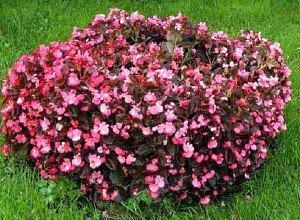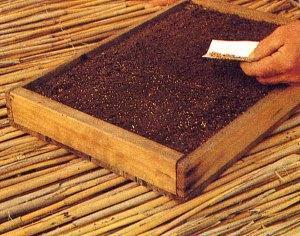Garden begonia - planting and care
 Unlike indoor begonias, its garden variety is excellent weather resistant and grows well in gardens and flower beds.
Unlike indoor begonias, its garden variety is excellent weather resistant and grows well in gardens and flower beds.
The color of this popular plant can be very diverse - from white to exquisite purple, and all varieties of garden begonia can be seen in the photo in the catalogs of florists and nurseries. Garden begonia is distinguished by compactness of bushes, the height of which does not exceed 25 cm.If you liked this plant and want to grow it yourself, you need to know how to plant and care for garden begonia. This plant is whimsical and does not tolerate mistakes.
Planting a garden begonia
Begonia of any variety is a light-loving plant, however, when planting a garden species, you need to choose shaded places. Direct sunlight negatively affects the development of the plant, and it blooms worse.
Having decided on a place for a flowering plant, wait for June, since it is in this month that the garden begonia is planted. The weather becomes warm and constant, and this is extremely important for a thermophilic plant, since even slight frosts or low temperatures can destroy the garden begonia.
You can plant begonia seedlings in open ground, purchased in advance in a specialized store, or grown independently from seeds at home.
Seedlings
We need:
- Priming;
- Garden begonia seeds;
- Seedling pot or box.

Boxes with seeds are covered with glass and placed in a warm place. You need to water as the soil dries up, carefully, otherwise small seeds can be washed off with water. After a week, begonia sprouts will appear, and at the age of 2-3 weeks they need to be dived into a separate pot. Planting seedlings of garden begonia is carried out at a distance of 2 cm from each other. After a month, begonia seedlings are suitable for planting in separate slides for growing.
Such begonia will bloom in the first year. However, to get early flowering, you need to use purchased seedlings with emerging buds.
Garden begonia care
When planting a garden begonia in open ground, peat and compost are poured into the hole, or they are replaced with any mineral fertilizer containing potassium and phosphorus. After planting, the soil must be shed with water, which will speed up the rooting of seedlings.
Caring for garden begonia involves regularly loosening the soil near the plantings, which will provide the root system with oxygen. The plant grows well only in moist soil, so the plantings are watered every three days, depending on weather conditions. With the establishment of dry and hot weather, it is necessary to water the garden begonia often, be sure to loosen the soil after watering. Water stagnation should not be allowed, as this causes rotting of the plant roots. For the purpose of prevention, when landing, any drainage material is laid on the bottom of the hole - expanded clay, coarse river sand, gravel, etc.
Begonia leaves do not need additional spraying; rather, on the contrary, water droplets do irreparable harm to them, as they cause brown spots. In autumn, on the eve of wintering, watering is stopped.
Winter care
 In early October, the tubers of the garden begonia need to be dug out for wintering... First, the stems are cut off from the plant, leaving a stump up to 3 cm high. The dug up tubers of garden begonia are dried in the room for two weeks. The remaining soil and stems are removed from the tubers, placed in a storage box and covered with sand.
In early October, the tubers of the garden begonia need to be dug out for wintering... First, the stems are cut off from the plant, leaving a stump up to 3 cm high. The dug up tubers of garden begonia are dried in the room for two weeks. The remaining soil and stems are removed from the tubers, placed in a storage box and covered with sand.
You need to store the container with tubers in a cool place. A refrigerator is also suitable for storing a small number of tubers.
Reproduction of garden begonia
At the end of winter, you can start sprouting begonia tubers. This is a good way to increase the amount of planting material for a flower garden. Wet sand is poured into a small box and begonia tubers are planted. When the first shoots appear, the tuber is cut so that at least one bud remains on each part of it. The cuts are sprinkled with crushed coal, dried for a couple of hours and then the seedlings of garden begonia are planted in pots. Care for such seedlings is the same as when growing begonias from seeds.
Every year, the tubers of garden begonia increase in size. Such a plant accumulates a lot of nutrients, therefore, every year the flowers become larger and larger.
Despite the fact that garden begonia is grown in the open field, it can be used for landscaping terraces, decorating window sills and balconies. Growing this plant as a pot culture does not in the least affect the splendor of its flowering.